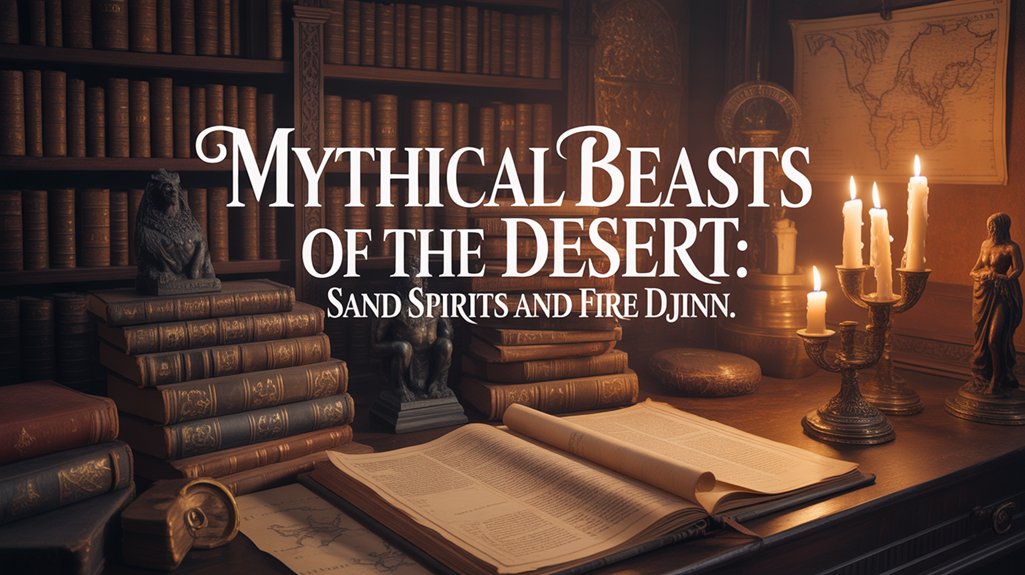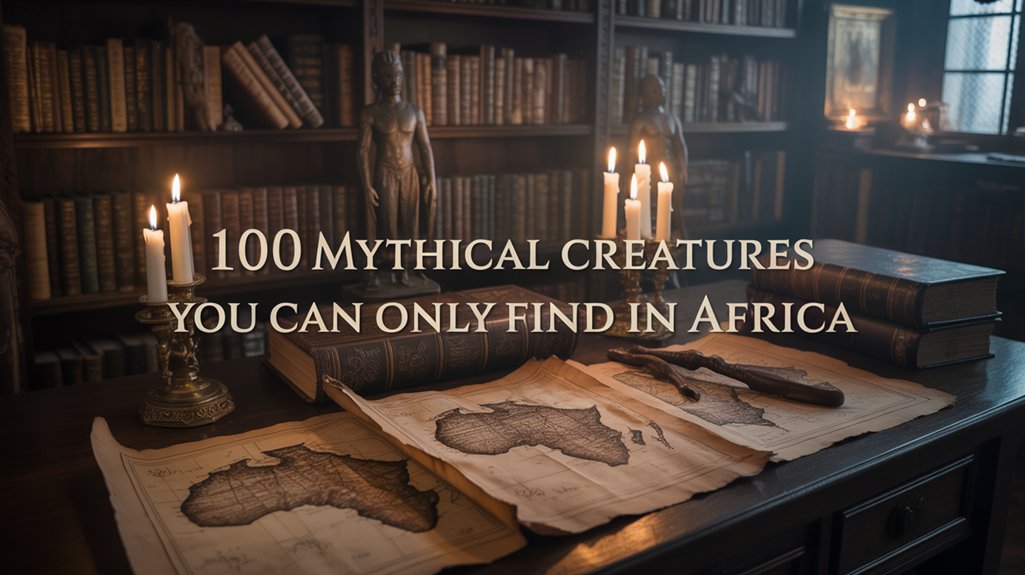
You’ll discover water nymphs wielded profound power over ancient civilizations through their dominion of freshwater springs, Mediterranean depths, and oceanic domains—naiads, nereids, and oceanids respectively. These divine feminine presences demanded blood sacrifices and dawn offerings of milk to bestow fertility blessings, guide sailors through tempestuous waters, and protect essential watersheds from desecration. Their transformative myths encoded environmental ethics: polluters faced supernatural retribution, while devotees received healing properties and agricultural abundance. The traditions spanning Hellenic riverbanks to distant shores reveal humanity’s ancestral recognition that respecting aquatic boundaries determined survival itself, wisdom awaiting your exploration.
Table of Contents
ToggleKey Takeaways
- Water nymphs served as divine guardians of freshwater springs, Mediterranean depths, and oceans, protecting their domains through nurturing or vengeful powers.
- Naiads, Nereids, and Oceanids possessed healing properties, guided sailors, and answered prayers, demonstrating their supernatural influence over aquatic realms.
- Ancient Greeks performed blood sacrifices, offered milk and livestock, and sang hymns at water sources to honor nymphs and secure blessings.
- Transformation myths like Arethusa’s and Hylas’s illustrated nymphs’ power to enforce ecological respect and punish those who violated sacred boundaries.
- Nymph worship encoded environmental ethics, linking spiritual devotion to water conservation through fear of divine retribution for pollution or disrespect.
Water’s Ancient Divine Guardians

Since humanity first gazed upon the mirrored surface of springs and heard the murmur of coursing rivers, civilizations across the Mediterranean basin recognized sentient forces dwelling within these aqueous domains—entities neither fully divine nor entirely mortal.
Water’s mirror revealed neither gods nor mortals—only the liminal beings dwelling between, guardians of humanity’s most vital element.
You’ll find these water nymphs—Naiads haunting freshwater springs, Nereids emerging from Mediterranean depths, Oceanids numbering three thousand strong—served as divine guardians of humanity’s most precious resource. Water symbolism permeated ancient consciousness; each ripple suggested presence, each current whispered secrets.
The Greeks practiced nymph worship with blood sacrifices near sacred springs, recognizing Naiads as conduits of eldritch healing properties. Nereids, daughters of ancient Nereus, guided sailors through treacherous passages. Pure function.
The Oceanids answered desperate invocations from storm-tossed voyagers. Yet these beings embodied chimeric duality—beneficent protectors who could change into vengeful destroyers when disrespected. Understanding this delicate balance meant survival in a world where water granted life and death with equal indifference.
##
You’ll discover that water nymphs existed in distinct hierarchies across Greek cosmology, each category bound to specific aquatic domains—Naiads to springs and brooks, Nereids to Mediterranean depths, Oceanids to the world-encircling stream of Oceanus himself.
These beings weren’t mere personifications but eldritch guardians whose powers ranged from prophetic vision to metamorphosis, their presence consecrating rivers like the Achelous and Peneus into sacred spaces where mortals sought divine favor through ritual ablution and sacrifice.
The myths reveal their chimeric nature: nurturing one moment, vengeful the next, capable of bestowing healing waters or dragging victims into liquid oblivion.
Types of Water Nymphs
The classification of water nymphs reveals an intricate taxonomy born from humanity’s ancient understanding of aquatic domains, where each spring, river, and ocean possessed its own divine feminine essence.
Naiads’ characteristics emerged through five distinct manifestations: Crinaeae dwelling in fountains, Limnades haunting lake depths, Pegaeae guarding springs, Potameides flowing through rivers, and Heleionomae inhabiting wetlands. Each embodied the eldritch nature of freshwater’s perpetual movement.
Nereids’ roles centered upon the Aegean’s salt-swept expanses, these fifty daughters offering sailors protection against tempestuous seas.
The Oceanids numbered three thousand strong, chimeric beings born of primordial Oceanus, their dominion extending beyond mere water to encompass clouds, flowers, and atmospheric phenomena.
You’ll discover these classifications weren’t arbitrary—they represented ancient cultures’ profound recognition that water’s divine feminine power demanded nuanced categorization.
Sacred Rivers and Deities
Beyond these careful distinctions of nymph-kind lay the rivers themselves—primordial veins through which the earth’s sacred blood coursed, each waterway manifestation of a deity whose essence permeated every ripple and eddy.
You’ll find that river worship demanded specific protocols: goats, lambs, milk poured at dawn. Never wine. The Greeks understood their Naiads as guardians of springs and streams, while Oceanus’s daughters—those eldritch Oceanids—commanded sailors’ desperate prayers across storm-wracked seas.
These weren’t mere superstitions binding ancient peoples. Water marked boundaries against malevolent forces, a chimeric threshold between mortal vulnerability and divine protection.
Through divine offerings, your ancestors negotiated with powers that sustained crops, filled cisterns, blessed voyages. Life itself flowed through these sacred channels, mediated by spirits who demanded recognition, respect, reverence.
These aquatic myths addressed timeless questions about humanity’s relationship with nature, offering narratives that reflected each culture’s unique values through tales of divine water spirits.
Powers and Divine Attributes
Where mortal flesh met divine essence, water nymphs wielded powers that transcended simple categorization—healing arts intertwined with prophetic vision, protective enchantments bound to destructive vengeance.
You’ll find Naiads channeling healing waters through their very existence, their energy symbiotically entwined with each spring’s purity. These nurturing spirits restored afflicted pilgrims who sought their sacred pools, yet their benevolence masked eldritch fury. Disrespect their territories, break oaths sworn upon their shores, and witness metamorphosis from benefactor to destroyer.
The Nereids extended maritime protection, guiding fishermen through tempestuous seas, while Oceanids commanded vast aquatic domains, receiving prayers for safe passage across their father’s infinite territory.
Divine duality defined them—simultaneously creative and destructive forces, their powers reflecting water’s own nature: life-giving sustenance that could drown worlds without remorse.
Myths of Transformation
When flesh yielded to bark, when limbs dissolved into crystalline currents, alteration became the ultimate expression of divine intervention—metamorphosis as salvation, punishment, transcendence.
You’ll find conversion symbolism woven throughout naiad mythology, where Daphne’s arboreal escape from Apollo demonstrates water spirits’ protective sovereignty over the vulnerable.
The eldritch beauty of these nymphs masked chimeric danger; Hylas vanished into their embrace, drawn beneath dark waters, never surfacing.
Their seductive shapeshifting served dual purposes: enchantment and entrapment. These cautionary tales warned you against broken oaths and ecological transgression.
When naiads changed form—becoming willows, springs, mist—they embodied water’s essential mutability. Respect the boundaries between mortal and divine.
Honor promises made near sacred streams. Otherwise, transformation awaits—not liberation, but dissolution into elements beyond your control.
These transformation narratives served as narrative shorthand for ritual practices performed at sacred water sites, connecting local institutions to the universal truths embodied by these spirits.
Greek Naiads’ First Written Accounts

When you trace the Naiads’ genesis through Homer’s verses—those eldritch passages in the *Iliad* and *Odyssey* where divine waters pulse with conscious intent—you’ll discover that these river spirits weren’t merely decorative flourishes but sacred cartographers of Greece’s hydrological soul.
The ancient poets divided freshwater domains with meticulous precision: springs bore their own guardians, rivers claimed separate nymphs, and lakes harbored distinct entities, each Naiad tethered to her specific geographic coordinates like living meridian lines.
You’re witnessing here the primordial mapping of sacred geography, where every flowing vein of water possessed its numinous keeper.
Homer’s Iliad Mentions Naiads
The crystalline verses of Homer’s *Iliad*, composed circa 750 BCE, preserve humanity’s earliest written witness to the Naiads—those eldritch guardians who dwelt within the rushing waters of Hellas, their presence woven into the very fabric of Greek consciousness.
You’ll discover these freshwater divinities inhabiting rivers and springs throughout the epic, their names bound to specific geographical localities. The Naiads’ nurturing roles emerge through their benevolent interactions with heroes, offering sustenance and protection to mortals who honored their sacred domains.
Ancient Greeks recognized freshwater significance as essential to survival, personifying these life-giving sources as spiritual entities deserving reverence. Homer’s documentation established foundational mythological framework, anchoring Naiads within literary tradition and demonstrating how Bronze Age peoples perceived nature as animate, conscious, eternal.
Springs, Rivers, Lakes Divided
Beyond Homer’s generalized references, subsequent Greek scribes rendered explicit the taxonomic divisions governing these freshwater spirits—a classification system reflecting profound geographical observation and spiritual cartography. You’ll discover that naiads’ habitats weren’t merely poetic designations but precise ecological demarcations, each category embodying distinct river ecosystems and their eldritch properties.
| Naiad Classification | Sacred Domain | Ecological Function |
|---|---|---|
| Crinaeae & Pegaeae | Fountains, Springs | Source waters, healing |
| Potameides | Rivers, Streams | Flow movement, travel |
| Limnades & Heleionomae | Lakes, Wetlands | Stagnant depths, mystery |
These taxonomies emerged through careful observation. Each spirit possessed chimeric attributes matching her waters—swift Potameides reflected rushing currents, while brooding Heleionomae embodied marsh-born miasmas. The classification revealed ancient ecological wisdom bound to divine presence.
Sacred Geography of Greece
As Homer’s verses crystallized into written form around the 8th century BCE, they established Greece’s earliest literary landscape—one where every spring possessed its presiding naiad, every river mouth its guardian spirit.
You’ll discover sacred springs scattered throughout Hellas, altering ordinary landscape into numinous terrain. Naiad rituals demanded careful observance: water offerings poured at dawn, libations of milk and honey consecrated to these eldritch guardians.
Cult worship flourished near their domains, sanctuaries nestled within groves where mortal supplication met divine presence. Towns bore their names—Salmacis, Castalia, Pirene—each toponym anchoring community identity to its aqueous protector.
This wasn’t mere folklore. The sacred geography of Greece reflected lived cosmology, where freshwater sources demarcated threshold spaces between human settlements and the chimeric domain beyond mortal comprehension.
Nereids, Oceanids, Naiads Compared

Among the aqueous divinities of ancient Greek cosmology, three distinct orders of nymphs emerge with carefully delineated domains and sacred responsibilities.
When examining Nereids vs. Naiads, you’ll discover fundamental distinctions. Nereids—fifty daughters of Nereus—commanded the Aegean’s salt-touched depths, nurturing sailors through treacherous passages. Naiads dwelt in freshwater springs, each bound to singular sources they fiercely protected. The Oceanids’ significance transcended both: three thousand daughters of primordial Oceanus embodied the world-encircling river itself.
| Characteristic | Nereids | Oceanids | Naiads |
|---|---|---|---|
| Domain | Aegean Sea | Ocean/freshwater | Springs, rivers |
| Number | 50 | ~3,000 | Countless |
| Temperament | Benevolent | Supportive | Vengeful potential |
| Cultural Role | Maritime protection | Voyage blessing | Local healing cults |
Consider Thetis, that eldritch Nereid who bore Achilles. Yet Hylas vanished into a Naiad’s jealous embrace—proof that freshwater spirits possessed darker inclinations. These weren’t interchangeable beings but specialized guardians occupying distinct ecological niches within Greece’s sacred waterscape.
Fertility and Life Force Connections
These specialized guardians of Greece’s aqueous domains commanded powers that extended far beyond their watery territories—their influence saturated the very soil, the sprouting grain, the swelling fruit upon the vine.
You’ll find that Naiads embodied the crucial life force coursing through agricultural communities, their presence determining whether crops flourished or withered, whether livestock thrived or perished.
Ancient peoples recognized these eldritch connections through elaborate fertility rituals:
- Offerings of honey, oil, and milk poured into sacred springs
- Seasonal ceremonies invoking nymphal blessings upon planted fields
- Devotional hymns sung at water sources during planting and harvest
- Animal sacrifices performed to guarantee pure, flowing water
- Ritual bathing in nymph-inhabited streams to promote conception
The nymphs’ dominion over water’s life force made them arbiters of existence itself—their favor meant abundance, their displeasure brought desolation.
Communities understood this chimeric relationship between flowing water and flowing life, between the nymph’s blessing and the land’s fecundity.
Arethusa’s Transformation Into Spring
You encounter in Arethusa’s tale perhaps the most poignant metamorphosis within the nymphaean tradition—a beautiful naiad fleeing the relentless desire of Alpheus, the river god whose waters pursued her across terrestrial boundaries until Artemis herself intervened.
The goddess shrouded her devotee in sacred mist, dissolving the nymph’s corporeal form into crystalline water that descended through chthonic passages, emerging triumphant on Sicilian shores as an eternal spring.
This alteration wasn’t mere escape but apotheosis: Arethusa became simultaneously sanctuary and sanctified waters, her consciousness preserved within the luminous fountain that still flows beneath Mediterranean sun.
Pursued by River Alpheus
When the river god Alpheus first glimpsed Arethusa bathing in his crystalline waters near the sacred groves of Elis, he became consumed by an obsessive desire that would alter the very landscape of the ancient Mediterranean world.
Arethusa’s escape began as desperate flight—she traversed mountains, valleys, and shorelines while Alpheus’ pursuit intensified with eldritch fervor.
The nymph invoked Artemis, who shrouded her in protective mist before enacting transformation. Arethusa dissolved into water itself. Her essence flowed underground, traversing hidden aquifers beneath the Ionian Sea to emerge at Ortygia.
Yet Alpheus proved equally protean; his river-form dove beneath earth’s surface, threading through subterranean channels.
Their waters ultimately merged at Syracuse—eternal union replacing conquest, illustrating how ancient forces transcend mortal boundaries of possession and autonomy.
Divine Intervention and Escape
Artemis stood at the threshold between violation and sovereignty when Arethusa’s desperate invocation pierced the veil separating mortal peril from divine mercy.
The goddess answered with instantaneous conversion, dissolving the nymph’s corporeal form into liquid essence—a divine escape wrought through elemental transmutation.
Arethusa’s nymph alteration erupted from limestone bedrock in Syracuse, Sicily, her consciousness flowing eternal, ungraspable by Alpheus’s possessive currents.
This eldritch intervention preserved autonomy through liquidity itself, demonstrating how ancient Hellenic theology understood freedom as fluid, protean, resistant to constraint.
The spring’s emergence crystallized divine feminine solidarity, goddess protecting suppliant through radical embodiment.
Water became sanctuary.
The transformation transcended mere physical alteration; it manifested sovereignty through dissolution, proving that true liberation sometimes requires abandoning familiar forms entirely, embracing chimeric existence beyond predatory reach.
Eternal Spring in Sicily
Through metamorphic alchemy, the hunted nymph achieved permanence in perpetual flow—Arethusa’s spring bursting forth from Sicilian earth circa 734 BCE, contemporaneous with Corinthian colonization of Syracuse, where limestone karst enabled her miraculous emergence.
You’ll find her waters still crystalline, still cold, carrying eldritch memories of alteration. The spring symbolism resonated profoundly: eternal feminine autonomy preserved through liquid incarnation, escape rendered immortal.
Ancient pilgrims tasted her healing currents, seeking remedies for corporeal ailments while honoring the nymph’s defiant metamorphosis. Arethusa’s legacy transcends mere geographical landmark—she embodies sacred refuge, the gods’ covenant to protect those who serve them faithfully.
Her perpetual flowing represents consciousness unbound, identity changed yet preserved. Freedom achieved through dissolution, through becoming something chimeric, neither fully divine nor mortal but elementally eternal.
Fantasy Literature Features Nymphs
Modern fantasy literature has altered water nymphs from their classical predecessors into complex literary figures that embody the fundamental tensions between civilization and wilderness, purity and corruption, desire and destruction.
You’ll discover contemporary authors weaving nymph symbolism through narratives that honor ancient water mythology while exploring themes forbidden to classical storytellers:
- Naiad guardians whose essence bleeds when rivers suffer pollution, their immortal bodies chimeric reflections of environmental devastation.
- Nereid seductresses ensnaring mortals in eldritch bargains, demanding oaths sworn upon salt and storm.
- Oceanid oracles speaking prophecies through tidal patterns, their voices carrying both benediction and curse.
- Spring nymphs bound to specific waters, dying when humanity’s iron touch corrupts their sacred pools.
- River spirits embodying duality—life-giver at dawn, drowning force at twilight.
These portrayals draw from Greek classifications yet transcend mere mythological recreation. They become symbols of untamed freedom, reminding you that nature’s beauty conceals profound danger, that desire leads toward alteration or annihilation.
Jung’s Archetype of Water Femininity
Carl Gustav Jung identified within water’s depths an archetype that transcends mere mythological cataloging—the anima aquatica, the water-feminine principle dwelling in humanity’s collective unconscious.
You’ll discover that Naiads and river spirits embody this archetype’s essential duality: nurturing fluidity paired with devastating power, life-giver and destroyer merged. These entities channel emotional currents from your psyche’s deepest wells, their eldritch presence mapping the unconscious mind’s labyrinthine pathways.
The water-feminine offers intuitive guidance through alteration’s turbulent passages. She doesn’t merely symbolize fertility—she *is* the generative force itself, chimeric in her aspects. Alluring yet perilous.
The water-feminine transcends symbolism—she embodies transformation’s generative essence, simultaneously seductive and treacherous in her primordial depths.
Ancient cultures recognized this archetypal truth, their reverence acknowledging feminine principles Jung later codified: emotional depth, creative flow, the dangerous wisdom residing in feeling’s primordial currents.
When you encounter water spirits in mythology, you’re confronting humanity’s recognition that alteration demands surrender to forces beyond rational control—the feminine mysteries dwelling where consciousness meets the vast, churning unknown.
Environmental Conservation Through Mythology
When ancient civilizations personified their waterways as divine feminine presences, they weren’t engaging in mere poetic fancy—they were encoding environmental ethics into their spiritual architecture.
The Naiads and Oceanids embodied mythical conservation, altering abstract ecological responsibility into tangible spiritual practice. Sacred waters demanded reverence through ritual sacrifice, community offerings that bound populations to their watersheds’ wellbeing.
These eldritch guardians punished contamination with supernatural vengeance. Polluters faced divine retribution.
The nymphs’ healing properties weren’t chimeric fantasy but recognition of clean water’s medicinal necessity, embedding public health within cosmological frameworks.
You see the genius here: by making rivers conscious, vengeful, feminine, ancient cultures created self-enforcing conservation systems. Folklore became environmental law, cautionary tales preventing degradation through supernatural fear rather than secular mandate.
This spiritual ecology persists wherever indigenous traditions remain unbroken, proving mythology’s power as conservation technology—altering abstract sustainability into visceral, sacred obligation that transcends rational argument alone.
Timeless Water Spirit Reverence
Across millennia and continents, water spirits have commanded humanity’s reverence through an unbroken thread of sacred recognition—from the Naiads who presided over Hellenic springs to the Slavic Rusalki haunting river depths, from West African Mami Wata rising from ocean foam to the Japanese Kappa guarding temple ponds.
Water spirits across cultures reveal humanity’s timeless recognition that survival depends upon respecting forces dwelling within rivers, springs, and seas.
You’ll discover water spirit traditions persisting despite civilization’s relentless march toward rationalization. Ancient nymph worship practices established protocols that modern societies unconsciously perpetuate—naming fountains after forgotten deities, tossing coins into wells, attributing healing properties to mineral springs.
The Naiads demanded sacrifices at sanctuaries throughout classical Greece, their eldritch presence guaranteeing water’s purity or withdrawing blessings from those who defiled their domains.
These chimeric beings embodied water’s dual essence: nurturing sustenance and merciless destruction. Towns carved their names into stone, acknowledging dependence upon forces beyond human control.
Today’s environmental movements echo ancestral wisdom—recognizing that our survival remains inextricably bound to waters these spirits once governed.
Frequently Asked Questions
How Did Ancient Civilizations Conduct Rituals to Honor Water Spirits?
You’d witness ancient civilizations performing water worship through elaborate offerings—casting precious metals, ceramics, flowers into sacred springs and rivers.
These ancient rituals demanded your participation at liminal hours, dawn and dusk, where priests chanted invocations in eldritch tongues.
You’d present libations, burn aromatic resins, sacrifice animals at riverbanks.
Communities gathered during solstices, honoring naiads and fluvial deities with processions, hymns, ritual bathing.
The numinous exchange between mortal and spirit required your reverence, your freedom intertwined with sacred waters.
What Offerings Were Traditionally Given to River Nymphs for Safe Passage?
You’d present sacred flowers—violets, lilies, water roses—alongside polished river stones gathered from threshold places where currents merged.
Ancient Greeks offered honey cakes, libations of wine poured directly into churning waters, while Celtic tribes left bronze mirrors, silver coins at ford-crossings.
These weren’t mere transactions but reciprocal exchanges, acknowledging the naiads’ eldritch sovereignty over liminal waterways.
You’d speak your intention aloud, invoking their ancient names, recognizing their power to grant or deny your passage through their fluid domains.
Can Water Nymphs Appear in Male Form Across Different Cultures?
You’ll find water nymphs exceeding fixed forms across mythologies, yet they’re mainly feminine.
Greek Naiads remain eternally female, their essence bound to springs and streams.
Germanic Nix, however, embodies true gender fluidity—appearing as both seductive maiden and eldritch male guardian.
Cultural variations reveal Slavic Vodyanoy, purely masculine river spirits who drown the unwary, while Japanese Kappa shift their chimeric forms freely.
This diversity reflects each culture’s understanding of water’s altering, boundary-dissolving nature—neither wholly male nor female, but fluid.
Which Modern Religions Still Incorporate Water Spirit Worship Today?
You’ll find water spirit worship thriving in modern religions across continents.
Shinto practitioners venerate kami dwelling in Japan’s sacred rivers and springs through ritualized offerings.
Vodou adherents honor Agwé, sovereign of aqueous domains, while Candomblé devotees serve Yemanjá with flower-strewn ceremonies at Brazil’s shores.
Hindu communities still propitiate nagas—serpentine water guardians—at temple tanks.
Indigenous traditions worldwide maintain these eldritch connections: from Māori taniwha reverence to West African Mami Wata veneration, proving ancient currents flow undiminished.
Are There Documented Cases of Water Spirit Sightings in Recent History?
Like mist clinging to forgotten shores, recent sightings persist in your modern world.
You’ll find documented paranormal encounters from Scotland’s Loch Ness to Japan’s kappa witnesses, recorded throughout the twentieth and twenty-first centuries.
Folklore archives contain sworn testimonies—eldritch presences glimpsed at twilight, chimeric forms breaking still waters.
These accounts, neither wholly dismissed nor confirmed, inhabit liminal spaces between belief and skepticism, suggesting ancient reverence for aquatic spirits hasn’t entirely dissolved into rationalist currents.
Conclusion
You’ve traced these eldritch currents through Hellenic springs, through Jung’s collective depths, through contemporary conservation. You’ve witnessed how naiads embody fertility’s sacred pulse, how Arethusa’s change mirrors your own alterations, how each fountain whispers ancestral wisdom. Now you stand at water’s edge—scholar and supplicant both—recognizing that these spirits aren’t mere myth but living archetypes. They flow through your consciousness, through ecological reverence, through humanity’s perpetual longing for the numinous feminine. The waters remember. You must too.












